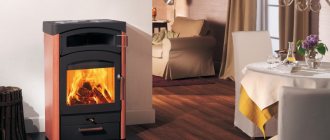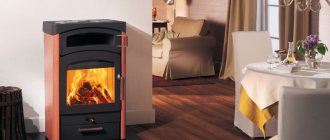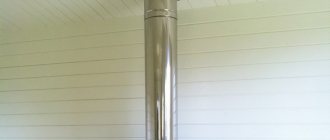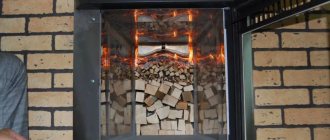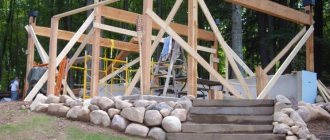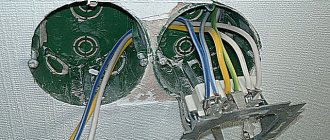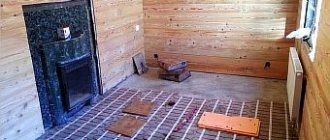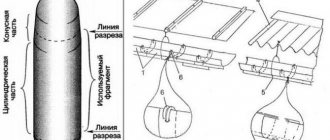Coal fireplace stoves are very popular today. This heating unit will be especially useful for a region where the cost of standard solid fuel, namely wood, is very high, which in turn makes the use of a solid fuel unit unprofitable. Also, homemade and purchased long-burning coal fireplaces for the home can be fully automated and operate independently. In this case, loading fuel will be done not with your own hands, but with the machine itself, which is very convenient.
Design features of coal furnaces
If you look closely at a coal stove and its most common wood-burning competitor, then, in principle, it will be difficult to find any special differences at first glance. But upon closer examination and familiarization with the operating principle of the furnace itself, it becomes clear that they differ fundamentally. (See also: Do-it-yourself housekeeper oven)
- The principle of combustion and air supply differs; if for wood-burning stoves the most efficient combustion can be achieved when air is supplied directly to the place of fuel combustion from above, then for coal stoves it is necessary to purify the fuel and supply the air mixture from below.
For wood-burning stoves, the use of dry fuel during the combustion process is not particularly critical. It is only important that the initial lighting of the stove occurs with dry material. Before adding coal to the furnace, it is advisable to preheat it in a special compartment of the furnace, which is heated by exhaust gases.
The design of the chimney for a coal-fired stove is somewhat different from its wood-burning counterparts and is designed for a higher air flow rate. And the flow itself and its speed are regulated not by a blower, but by a blower. The damper itself, blocking the chimney (yushka), is completely absent. This feature is due to the fact that coal stoves smolder for a very long time, and do not quickly burn through fuel like wood stoves. The disadvantages of coal stoves are also associated with this feature:
- It is impossible to block the chimney to prevent the weathering of heat due to the danger of carbon monoxide poisoning, and therefore coal heating stoves cool down quite quickly.
- For normal combustion of a coal furnace, it is advisable to exclude the presence of combustion products in its lower compartment. To do this, it is necessary to periodically clean the ashpit, which will be constantly replenished with burnt coal. In this case, cleaning must occur more often than is necessary for a wood stove.
The walls of coal stoves must withstand higher temperatures than conventional wood stoves; accordingly, they will be thicker, and more heat-resistant materials must be used for their assembly.
(See also: DIY camp stove)
A coal stove may have a special design for loading fuel, this is due to the higher ignition temperature of coal - that is, it will not be possible to light such a stove with just a piece of newspaper and matches. Therefore, in a coal stove, firewood is first lit, and coal is loaded on top, which gradually flares up as the wood burns out.
In practice, combination stoves are often used, in which both coal and wood can be burned simultaneously. In addition, peat briquettes, which burn very much like coal, can also be used as fuel. In combined devices, all elements of both a coal and wood stove are simultaneously present.
Best models
Let's look at the best factory-made models, and then move on to making a coal stove with your own hands. These models are suitable even for a large country cottage. You can buy them on the manufacturer’s website by submitting an online application.
| Name and price (RUB) | Characteristics | ||||
| Room area m2 | power, kWt | Dimensions, mm Chimney, mm | Weight, kg | ||
| Zota stakhanov 100, from 370000 | 1000 | 100 | 900x1608x1796, 800 | 880 | |
| Teplov T-100, from 185000 | 1000 | 100 | 1770x810x810, 250 | 900 | |
| Vulkan EKO-100, from 330000 | 1500 | 100 | 1770x810x810, 250 | 900 | |
| “Bourgeois-K” T-100A-2K, from 272000 | 1000 | 100 | 780x1420x1890, 250 | 900 | |
| Ferroli Forest 100, from 1200000 | 1000 | 115 | 2898x4533x2700, 200 | 1230 | |
Coal
Coal is a traditional raw material for solid fuel boilers. It burns for a long time and has good heat transfer, but only if it is correctly placed in the combustion chamber, properly ignited and subsequently maintained.
Coal selection
To increase the efficiency of the boiler and extend its service life, it is necessary to take into account the manufacturer’s recommendations for choosing the grade of coal. Usually the name of the brand and its fraction are indicated in the technical data sheet of the device. Each grade has a different ratio of carbon and impurities, different humidity, structure, strength and age of formation.
The most popular types of coal for solid fuel boilers:
- Coal. The heat transfer of the fuel is 5500 kcal/kg. The average percentage of carbon and ash is 75%/3%. Suitable for igniting most classic boiler models.
- Anthracite. Specific heat indicators are 9000 kcal/hour. The percentage of carbon is no more than 7%. The disadvantage of this variety is difficulty in ignition and extremely high combustion temperature.
The most popular and convenient for ignition is long-flame coal. This universal fuel for all types of boilers ignites quickly, burns for a long time and releases a large amount of energy.
Brown coal and lingite can be found on sale. However, these varieties are recommended for use only on an industrial scale due to the large amount of ash residue and high humidity levels.
How to fire a boiler with coal
The solid fuel installation consists of two main chambers: the upper one is used to store fuel, and the lower one (ash pan) is used to collect ash and slag. As the fuel burns in the main chamber, the combustion products gradually fall into the ash pan, from where they are removed manually.
Before starting melting, it is necessary to prepare the installation for operation. To do this, solid combustion products are removed from the ash pan, the walls of the combustion chamber are wiped and the chimney channels are cleaned.
As soon as the preparatory work is completed, you can begin loading fuel and igniting.
- Place dry paper on the grid of the main chamber. It is recommended to crumple it up first - this way it will light faster.
- Place wood chips and brushwood evenly on top in the shape of a well or hut.
- Light a match and bring it to the paper from different sides - the paper will burn evenly, involving wood chips in the process.
- Close the firebox door and open the ash pan valve to allow oxygen to enter. At this stage, you will have to monitor the combustion process of the wood chips. You can adjust the intensity using the ash pan (ash pan) door.
- As soon as the wood chips burn completely, pour a small layer of fine coal on top. Its amount should not exceed a third of the combustion chamber.
- After loading the first batch of coal, close the door again to achieve maximum combustion temperature. This usually takes about
- When the first layer of fuel completely engulfs the flame, add the remaining coal to the upper border of the door. It is recommended to stir the burning coal slightly beforehand.
- Close the blower door halfway. If there is strong smoking, leave a small crack.
As combustion proceeds, fuel is added in small portions to the main chamber, each time closing the ash pan damper. You should not put in a large amount of coal at once - this will lead to the fuel solidifying on the grate and its premature deterioration.
Recommendations for masonry
To lay a stove where you plan to burn coal, you will need 2 types of mortar - clay-sand and fireproof. With the help of the first, the body of the furnace is built from solid ceramic bricks, and the second is used for the internal masonry of fireclay stones. The thickness of the seams also differs: for ordinary masonry it is a maximum of 5 mm, for fireproof masonry - 3 mm.
To prepare both types of mortar, it is recommended to purchase ready-made construction mixtures that are commercially available. Only experienced stove makers can make a good solution from natural clay. You also need to prepare masonry and measuring tools, and then start building the stove:
- Before laying on the mortar, each row of bricks must be laid out dry to try on and adjust the stones to size.
- Before putting the brick in place, it must be dipped in a bucket of water.
- It is advisable to place the stones in one precise movement so that you have to tap less.
- Trim off the remaining mortar on the front side with a trowel, and wipe dry on the smoke exhaust side with a rag.
- Control each row horizontally and vertically.
- Leave a 5 cm wide gap between regular and fireclay masonry, which is then filled with basalt fiber.
- Install a cast iron stove with burners and doors using rolled metal support elements.
The stove solution does not harden, but dries, for which it needs to be given 2-3 days. Afterwards, all that remains is to lay out the chimney, observing the rules for passing through the floors and roof, and at the end make a test firebox. You can fill the stove with coal only after it has completely warmed up, making sure that there are no cracks or crevices.
Firewood
Firewood is another popular type of fuel for boilers. Only dried wood is suitable for burning. Under-dried firewood in the firebox begins to release moisture, which accumulates on the internal surfaces of the firebox and chimney. In combination with smoke and carbon monoxide, tar is formed - it reduces the operational properties of the boiler and reduces the permeability of exhaust gases.
Firewood selection
For melting, hardwood with a long burning life and slow heat transfer is optimal. Preference should be given to deciduous trees over coniferous ones. During the combustion process, conifers emit a large amount of resinous substances and quickly pollute the combustion chamber and heat exchanger.
According to the degree of hardness, wood species are divided into 3 categories:
- hard - white acacia, ash, beech, oak, maple, yew, hazel, pear;
- medium hard - walnut, alder, sycamore, birch, cherry, cherry, cedar;
- soft - poplar, aspen.
How to heat a boiler with wood
- At the first stage, it is necessary to warm up the heating device well. This will prevent smoke from leaking into the room. Sheets of paper are placed at the bottom of the fuel chamber, on them are flammable birch bark, chips and splinters, and on top are small logs (up to 15 cm in diameter). The space between the chips can be filled with paper for faster ignition.
- When the firebox is about half full, you should set fire to the paper and open the ash pan valve for better draft. Close the main chamber door.
- When the chamber and chimney warm up and the preparatory filling begins to burn out, the firebox can be filled with large firewood. You can lay out the logs in a row or in the form of a well, leaving gaps between them for air penetration.
- As the firewood burns out, you will need to make a new stack without waiting for the previous one to die out.
Long-burning boilers greatly simplify the work. Fuel is added to them once every 6 hours due to automatic regulation of draft and combustion process. Such devices should be melted in accordance with the attached instructions.
How to calculate coal consumption
Coal consumption in a solid fuel boiler depends on many factors. Costs are affected by:
- Heated area.
- Amount of heat loss.
- Ambient temperature.
Exact costs can only be calculated after the end of the heating season. Moreover, depending on the winter, the average consumption of coal for heating can vary from 8 to 15 tons (for a building of 200 m²).
If you make average calculations based on actual operating experience, you can obtain the following data:
- Costs for September – October will be 1 bucket per day.
- Fuel consumption rates in a coal boiler from November to February will increase to 10 buckets per day.
- In March and April, you will need to burn 1-2 buckets per day.
Calculating the coal consumption for a 20 kW boiler, using the above data, will show that the costs during the heating season will be 580 buckets or 10-10.5 tons.
How to do it yourself
- The design of a brick stove burning coal or briquettes is quite simple; you just need to meet two conditions:
the firebox must be made of refractory bricks; The stove must be equipped with cleaning systems in all areas of the chimney.
The ordering diagram of a universal oven is shown in the figure. Thanks to a simple device, you can do it yourself, even without experience. The stove is small in size and can be used to heat a country house or village house with an area of up to 36 square meters, consisting of one or two rooms. In the latter case, the firebox is located on the kitchen side, and the back wall, which heats up during the fire, is brought into the room.
The stove consists of a firebox, lined with your own hands from refractory fireclay bricks, and a firebox channel with one cover.
Flue gases are retained in the channel, a cap effect is created, and the furnace body warms up. After cooling, the smoke descends and exits through the chimney. It is equipped with two valves that eliminate sharp boundaries between warm and cold air and moisture condensation.
Below the firebox there is a ash pan combined with an ash pan. Pressurization is carried out through a grate; air movement is ensured by a simple chimney design and good draft.
- The furnace is installed on a free-standing foundation made of reinforced concrete. The dimensions of the foundation should be 5-10 cm larger than the dimensions of the furnace, its height should be 50-70 cm, and it should be 15 cm below the level of the finished floor covering. After the foundation has been poured and dried, it is leveled with cement mortar, two layers of roofing felt or other rolled waterproofing are laid on it, after which they begin laying the furnace with their own hands.
- They lay out two rows of brick - the base of the stove, in solid masonry with a bandage of red brick. They are placed on cement mortar.
- Next, the masonry is carried out in accordance with the diagram using a solution of fireclay clay. The first row forms the bottom of the ash pan.
- In the second and third rows, place the blower door, securing it with annealed wire placed between the bricks.
- The fourth row forms the overlap of the ash chamber and an opening for blowing and removing ash from the firebox.
- Starting from the fifth row, the laying is done with fireclay bricks. A grate is laid in the fifth row.
- In the sixth and seventh, the firebox door is installed in the same way as the blower door.
- Rows 9 to 11 form the walls of the firebox; they are placed with a bandage.
- In the 12th row, a vault is made from ¾ of the brick, and in rows 13 and 14, the vault is covered.
- In the 15th row, a cleaning door and a cover are installed.
- Starting from the 16th row, the masonry is again made of red brick. Smoke channels are laid out according to the diagram.
- Valves are installed in rows 25 and 32.
- Rows 33 and 34 complete the overlap of the stove, then lay out the chimney of the required height.
- The stove is dried in air, then carefully heated in multi-steps, first with wood, and after several fireboxes - with coal. During operation, it is allowed to use any solid fuel: coal, anthracite, firewood and wood waste, pellets and briquettes.
Any metal stove with a long-burning effect can be used to fire coal. by laying out a fireclay brick lining in the firebox with your own hands and equipping the vent with a fan. With this modification, the metal of the furnace will not burn out from high temperatures, and the coal will burn steadily for a long time.
Possible problems and solutions
It happens that the stove seemed to light up normally, but other problems appeared during the fire. What to do, what measures to take to eliminate them? Here are the main problems and ways to get rid of them:
- The stove structure heats up unevenly, the temperature inside the stove for burning coal is low. There may be several reasons: low quality coal, a poorly closed fire door, the presence of cracks. To improve the quality of the fuel, it must be slightly moistened with water.
- A partial burst of flame is observed. This happens in two cases: they forgot to open the smoke damper or the natural draft decreases due to strong wind.
- The presence of a white flame and a hum in the firebox indicates too much draft. To fix the problem, you need to cover the vent a little.
- Smoke returns to the room. This is evidence of cracks in the heating system. Another reason is a large accumulation of soot in the chimney, due to which smoke cannot escape outside normally.
When burning coal, you must adhere to operating and fire safety rules. It is not difficult. And if you heat it correctly, the stove will bring warmth, homeliness, joy and comfort to your family. Enjoy this family hearth for many years to come!
Advice! Do not rush to part with coal dust, as it is an excellent fuel.
Homemade potbelly stove
Recently, many designers have been offering exclusive versions of potbelly stoves or fireplace stoves that are installed in country houses. For residents of prestigious cottages, they are not only an additional source of heat, but also a beautiful accessory for the interior design of the room. Such individual stoves fill the room with warmth and special comfort. Firewood crackling in a stove or fireplace looks very beautiful and romantic when a winter blizzard is raging outside the window.
The most popular, primitive and effective long-burning stove for temporary heating is the well-known potbelly stove. Its simple design is based on the “symbiosis” of a Russian stove and fireplace. With one load of fuel, it is capable of maintaining a comfortable indoor temperature for 4 hours. The potbelly stove can be installed in any space where a chimney can be removed.
Today, anyone who has the skills to perform plumbing work can make a potbelly stove with their own hands from all kinds of available materials. This oven:
- Does not depend on electricity or gas.
- Easy to maintain and operate.
- Allows you to control the combustion process.
- Takes up little space.
- Compact and economical.
- May have a hole for installing utensils to cook food or heat water.
Among the disadvantages of such a furnace, it should be noted the low efficiency, high speed of exhaust gases and rapid cooling. Therefore, to maintain the temperature in the room, it must be heated constantly.
The following can be used as fuel for a potbelly stove:
Materials and equipment for independent work
Our craftsmen make potbelly stoves with a welding machine on hand and used:
- large cans;
- metal corners;
- wide pipes;
- gas cylinders;
- metal boxes;
- large fire extinguishers;
- old barrels;
- steel sheets;
- chimney pipes;
- metal gratings.
For ease of work, you can also use factory-produced technical fittings in the form of:
Main elements of the combustion unit
Detailed drawings are not needed to make a potbelly stove. The main thing is to get the most efficient design possible. Let's look at the main components that make up a homemade stove.
Combustion chamber
It is the combustion chamber that performs the function of heat transfer. The larger the outer surface area, the better.
It is important that the bottom of the chamber has sufficient area to place firewood or coal there. Therefore, cylindrical homemade devices are placed on their sides
Rectangular ovens are designed in a horizontal design with a minimum size of 250x350 mm.
Large stoves made from barrels or gas cylinders are also practical in a vertical position.
Type of finished product
An additional ash pan welded or screwed to the bottom of the structure is convenient for selecting ash. Its arrangement with a blower promotes better heat generation, and the lower door ensures the supply of the required amount of oxygen and regulation of combustion intensity.
Doors and openings
These elements are made with your own hands from the leftover metal after cutting out the openings. After all, the scraps from the cylinders repeat the bend of the surface, and this is very important in work. Steel door canopies are attached to the body by welding, and then the doors themselves are hung on them.
Here it is necessary to provide a locking device, which can be made like a guillotine bolt or bolt.
The optimal openings for the firebox have dimensions of 250x250 mm, for the blower - a height of 100 and a width of 250 mm. Canopies are installed on one vertical axis. A distance of approximately 10 centimeters is maintained between the openings. To prevent coals from falling out of the door, the firebox opening is located slightly above the level of the grate.
To remove flue gases in a potbelly stove, a steel pipe with a diameter of 100–150 mm is used. The pipe itself is not insulated - it serves as an additional source of heat. And for better heat transfer, it is placed towards the outlet with inclined or horizontal sections, thereby increasing the path of warm gases.
The outlet pipe for connecting the chimney is located on top or, preferably, on the side. The latter option slows down the removal of gases, leaving space for the cooking zone.
Note! In the chimney, to regulate the intensity of removal of hot gases, it is advisable to use a rotary or guide valve
Modern coal stoves for home description, types
A coal stove for the home has many advantages. The main ones are ease of operation and maintenance, the possibility of using another type of solid fuel instead of coal, and high heat capacity. And besides, such a coal-heated stove for a country house can be made of different materials.
A coal stove has high efficiency levels (about 60 percent, which corresponds to boilers for heating systems that use liquid fuel). Modern models allow you to control the combustion of coal in the furnace and regulate this process for a more rational use of fuel and heat.
Modern coal-fired stoves come in several types, depending on their purpose:
- heating stoves;
- heating and cooking stoves;
- household;
- stoves-fireplaces.
Modern stoves are made from different materials: refractory brick, cast iron, steel, soapstone, etc.
Where to buy a long-burning coal boiler for heating a private home
In Moscow
- Stoves-Fireplaces – st. Yubileinaya, 4 building A, tel. +7 (495) 215–56–94.
- Comfort - Dmitrovskoe highway, 100, building 2, tel. +7 (495) 921–37–61.
In St. Petersburg
- TechnoDom - 57 Stachek Ave., Komsomolskaya Square, tel. +7 (812) 671–00–88.
- Kit-Teplo - st. Litovskaya 8, +7 (812) 295–00–05, +7 (812) 248–18–88.
In conclusion, it is worth saying that the efficiency and economy of the heating system depends not least on the skill of the user, therefore, in order for a long-burning coal boiler to serve well for more than one season, it is necessary to learn how to properly operate the equipment and care for it.
Long burning boilersSolid fuel boilersCoal boilers
Is it possible to heat with coal?
Many owners of stove-heated homes are wondering: is it possible to use coal instead of firewood in a brick stove? Will it burn as efficiently as in industrial boilers?
The process of coal combustion occurs with the release of a large amount of heat; the temperature in the firebox is much higher than when burning wood. At the same time, the smoke coming out of the firebox is less hot than when burning wood.
For this reason, a conventional stove with long smoke channels cannot be fired with coal: the smoke entering the chimney will have too low a temperature, which will lead to the formation of condensation and soot. When they interact, they form carbonic acid, which destroys the bricks, which can ultimately cause a fire.
In addition, increased temperature in the firebox can cause its destruction. The firebox for a coal stove made of bricks must be made only from fireclay bricks, and the walls of the stove in this place must be thicker for high-quality heat removal and accumulation.
It is not recommended to burn an ordinary Russian stove with coal. having an unlined firebox and extended smoke channels! This will lead to the gradual destruction of the oven elements!
Features of coal combustion
Firewood is the most ancient type of fuel, and this is explained by the fact that it is easy to obtain and set on fire. Dry wood burns without additional pressurization, and combustion occurs in two stages: first, the logs are charred with the release of flammable gases - so-called pyrolysis, and then the gases themselves burn, forming a flame, the height of which can reach several meters.
Wood-burning stoves and long-burning boilers usually consist of two chambers or zones: in one, wood decomposes into smoke and ash, in the other, flue gases burn and the most intense heating of the furnace walls occurs. A similar effect is achieved in brick kilns - flames and hot smoke pass through the smoke channels, heating a large area of the brick, while the body of the kiln is heated evenly.
Coal combustion occurs differently. The greatest heating is observed on the surface of the fuel, and the smoke temperature at the outlet is relatively low. Therefore, the effect of long-term burning of coal furnaces is the large size of the load and the placement of the heat exchanger directly in the fuel combustion zone. In brick stoves, the thickness of the walls of the firebox is increased, and the smoke circulation is made less extensive and accessible for cleaning with your own hands.
Another feature of effective coal combustion is the need for forced air injection into the combustion zone. In industrial furnaces and boilers, this problem is solved by installing a blower fan. A brick oven requires a well-thought-out design of the blower and chimney to ensure good draft.
Also, before installing a coal stove with your own hands, you need to provide a place to store fuel reserves. Coal is usually purchased for one season; storing it longer is not recommended, as anthracite cakes. Therefore, you need a separate storage room, protected from rain and wind.
You also need to consider the installation location of the boiler or furnace. Coal, unlike firewood, generates dust and stains household items, and the smoke from coal smells unpleasant. Therefore, it is better to place the firebox of a coal furnace in a separate room, and the boiler connected to the water heating system should generally be placed in a boiler room located near the fuel warehouse.
Other types of boiler fuel
Alternative types of fuel can be used to operate a solid fuel boiler.
Coal briquettes. The fuel is produced by pressing small fractions of coal and coal dust. They use minerals or coal tar as a binder. The advantages of this type of fuel are ease of installation and kindling, high calorific values and excellent flammability.
Pressed peat or wooden eurobriquettes. Fuel briquettes made from peat have a small area, but are capable of smoldering for a long time, maintaining the active combustion phase.
Pellets. This is biofuel made in the form of granules. Peat, wood and agricultural waste are used for production. This is an environmentally friendly and energy-efficient material, which is preferable to use in boilers whose design is adapted to pellets.
How to choose
Advantages of long-burning steel boilers:
- one-piece welded structure, not subject to leaks;
- rapid heating and cooling of the boiler walls and heat exchanger;
- Full automation is possible due to low inertia;
- less weight;
- reasonable price.
Disadvantages of steel models:
- susceptibility to corrosion, especially in welding areas;
- steel boilers cannot be repaired; in case of through corrosion and leaks, the unit is replaced with a new one.
The advantages of long-burning cast iron boilers include:
- resistance of cast iron to corrosion;
- the design of the heat exchanger from separate sections allows for partial replacement in case of damage;
- cast iron is a brittle and non-plastic material; in the event of a sudden change in temperature, cracks and destruction are possible;
- higher price than steel models;
- cast iron boilers are much heavier - 1.5-2.5 times.
Load volume and automation The frequency of filling the combustion chamber with coal depends on this characteristic. It is worth analyzing whether it will be convenient to load coal several times a day, or whether it is better to give preference to models with a large loading volume. The record holders for operating time are top-burning shaft-type boilers. They occupy a small area, while their loading chamber is quite large, and some models can heat a house for 5 days on anthracite and 3 days on brown coal on one load. Mine boilers are usually equipped with microcontrollers, which make it possible to automate the entire process and reduce maintenance to a minimum. Bottom-loading boilers, as a rule, are equipped with a smaller firebox, and they are much cheaper than mine boilers and are easier to use. Such boilers usually do not have a blower fan, and air flow occurs due to draft. The chimney for such a boiler should be as simple as possible and have a total length of no more than 5 meters. The advantages of boilers without draft are independence from electricity and low price. Disadvantages - low level of automation. Fully automated models with a loading hopper that can hold a multi-day amount of fuel require the least attention and maintenance. Their price, of course, is high, but they have a number of advantages that provide worry-free heating throughout the season:
- fuel supply mechanism equipped with a agitator;
- built-in and remote sensors that control the combustion process;
- emergency valves that prevent boiling;
- SMS alarm mode;
- combustion function and standby mode;
- DHW circuit.
Boiler maintenance comes down to loading the bunker at the beginning of the season and setting the parameters of the required mode.
Video: automated boiler with hopper
Choosing and purchasing a boiler is not an easy task, and given the cost of modern models, it is also expensive. Therefore, for small private or country houses, you can evaluate your strength and make a coal stove with your own hands.
Coal fired industrial boilers
When choosing a heating device for a home that runs on coal fuel, most owners of country houses opt for long-burning boilers.
They have a whole list of advantages:
- the boiler is installed in a separate room and connected to a water heating system, as a result the house remains clean and there is no smell of smoke;
- boilers are economical, have high efficiency and good heat transfer;
- a well-thought-out design provides a small amount of ash, they rarely have to be cleaned;
- The operating mode on one load for industrial boilers can reach several days, and if you provide a bunker for loading fuel and automatic supply, even several weeks;
- Expensive boiler models are equipped with automation systems; maintenance is kept to a minimum.
You can also note a number of difficulties that arise when purchasing a coal boiler:
- the need to equip a fuel warehouse and boiler room;
- due to the low temperature of the smoke, condensation and overgrowing of the chimney with soot is possible, so regular cleaning is necessary;
- high price of industrial boilers and related equipment.
For heating a country house or cottage with permanent residence, an industrial boiler with process automation is the best choice, despite the difficulties encountered in its installation and high price. The costs will be recouped over several heating seasons, and the operation of the boiler will be safe and economical.
Video: coal boiler
Preparatory stage of lighting the stove
If you are planning to light a stove that has not been used for a long time, you should carry out a number of preparatory measures.
This procedure must be carried out in order to ensure trouble-free operation of the stove, as well as to avoid unpleasant situations that sometimes lead to fires or harm to human health and life. • Inspect for cracks. Their presence can facilitate the penetration of smoke and even carbon monoxide into the room. If any are found, minor repairs should be immediately carried out using a mixture of clay and sand. • Clean soot from all flues and chimneys. Wipe off dust from the internal walls with a dry rag so as not to smell a bad aroma when kindling. In general, it is advisable to perform this procedure 2-3 times a month.
• Pay attention to the doors, especially their fit and the functionality of the locking mechanisms, to avoid the appearance of smoke. • Select fuel of the appropriate quality, suitable specifically for your type of stove
• Properly equip solid fuel storage areas.
During further operation, you should also follow a number of simple rules. Using plastic, construction and household waste for kindling will lead to severe contamination of the stove. It is incorrect to open the vent and the oven door at the same time. It should be heated several times a day for one and a half to two hours to avoid overheating. Dry, medium-sized, dust-free charcoal will provide excellent functionality.
Avoid storing flammable objects near hot walls. Do not leave the stove unattended while lighting, especially in homes with children.
What not to do?
When burning coal in a stove, the following is prohibited:
- use pieces of bitumen, plastic, construction and household waste as kindling material;
- leave the vent and combustion door open at the same time;
- When lighting, use gasoline, kerosene, alcohol, and other flammable substances.
It should be remembered that adults should constantly monitor the combustion process and under no circumstances transfer this function to children.
To ensure maximum heat transfer, it is necessary that the coal be in the form of not too large pieces. It is not recommended to use excessively wet fuel, since during combustion a lot of steam will be released from its surface, which will significantly reduce the efficiency of the combustion process.


